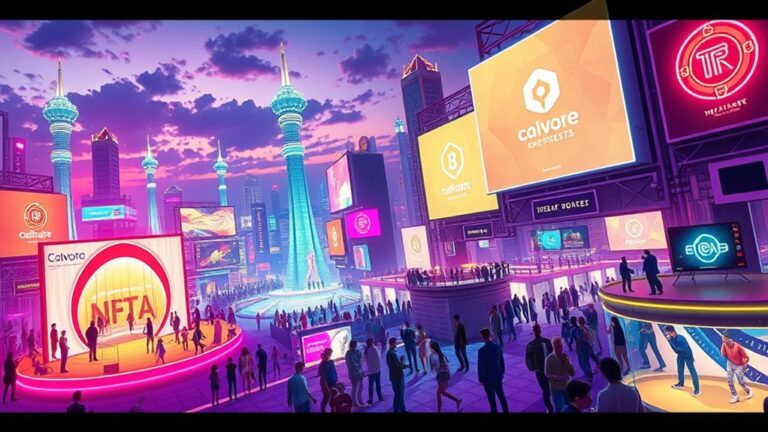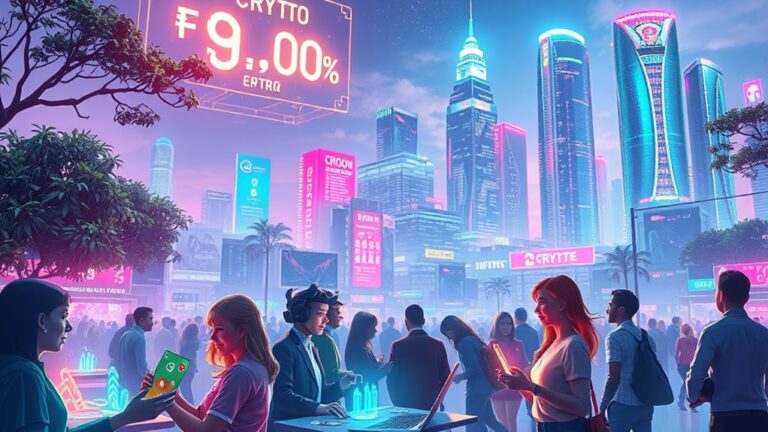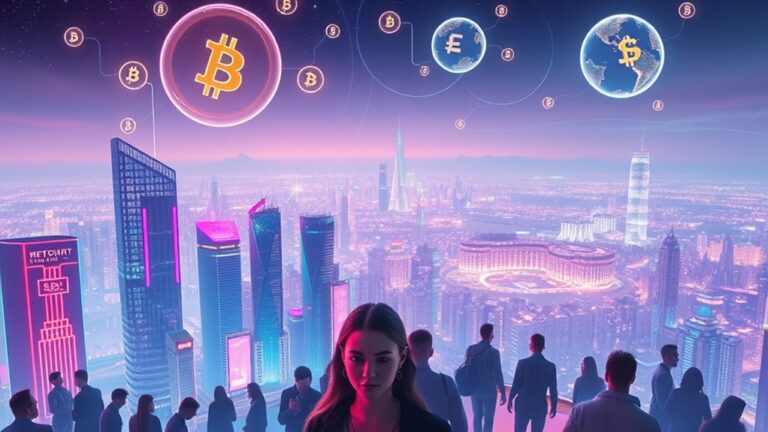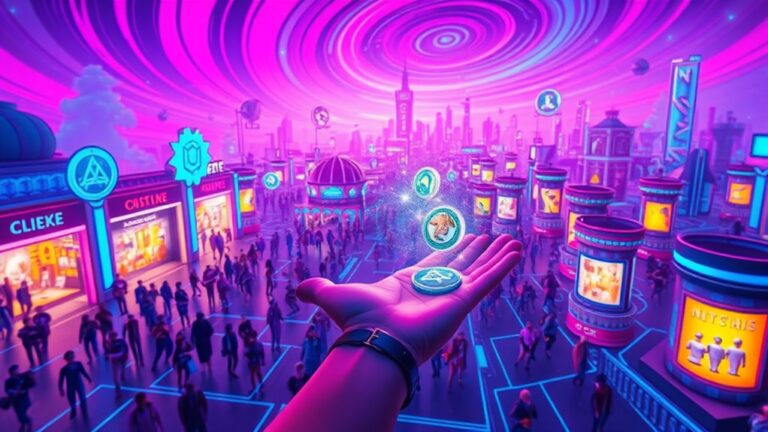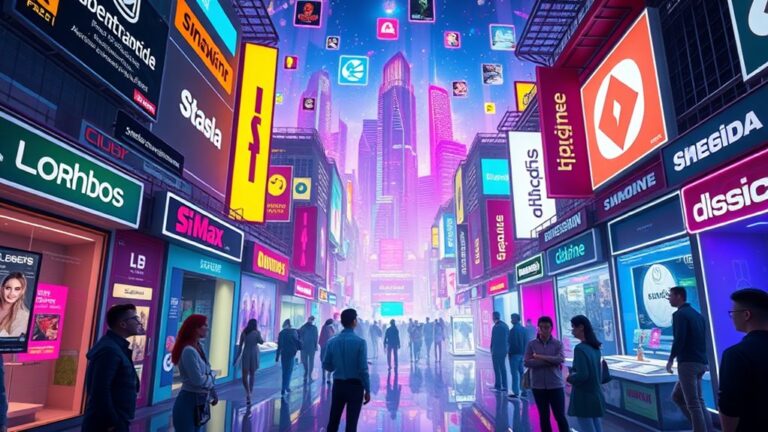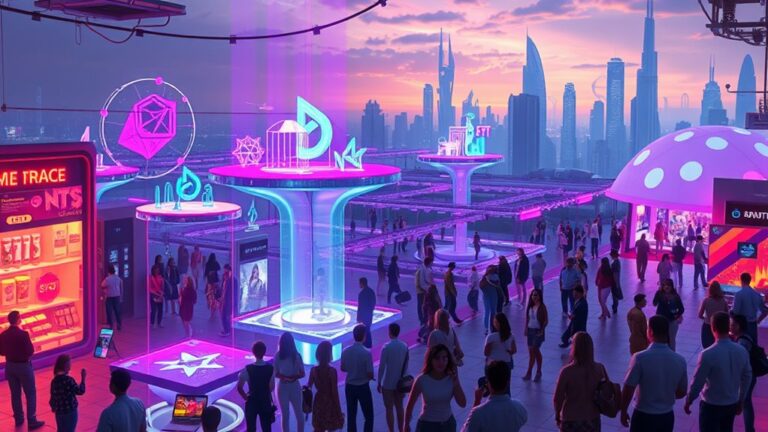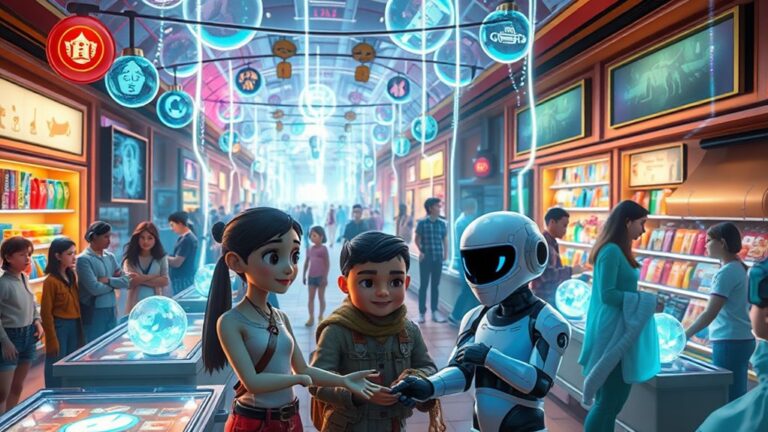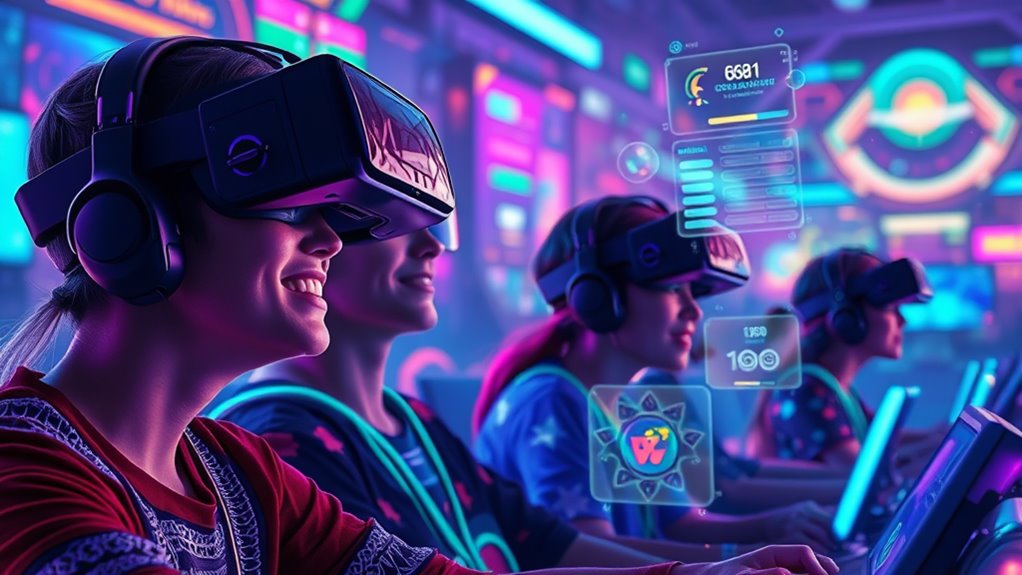
Metaverse and Web3 Gaming Platforms: Top Trends for Player Engagement
Metaverse and Web3 gaming platforms are shaping player engagement through several key trends. Immersive experiences are created using technologies like virtual reality and artificial intelligence. Community building is fostered by user-generated content and cooperative gameplay, while financial opportunities arise through play-to-earn models. Digital ownership is secured via blockchain technology, ensuring players control their assets. Cross-platform portability enhances player flexibility. As these trends continue to evolve, deeper insights into their impact will emerge.
Key Takeaways
- Immersive technologies like AR and VR create engaging interactive worlds, enhancing player experiences in the metaverse.
- Community-driven platforms foster social interactions, strengthening ties through collaborative gameplay and user-generated content.
- Play-to-earn models incentivize player participation by generating real-world income through in-game activities and asset trading.
- Cross-platform portability allows players to utilize digital assets across various games, increasing their value and enhancing digital identity.
- Blockchain technology ensures secure transactions and verifiable ownership, promoting trust and fairness in virtual economies.
Immersive Experiences in Metaverse Gaming

In recent years, the emergence of the metaverse has transformed the gaming landscape, offering players immersive experiences that blend reality with virtual environments.
Technologies such as augmented reality (AR) and virtual reality (VR) enable users to engage with expansive, interactive worlds. Players can explore these environments, which often feature realistic simulations and dynamic interactions.
Blockchain technology allows for ownership of virtual assets, enhancing player engagement and investment in their experiences.
Blockchain technology empowers players with true ownership of virtual assets, deepening their engagement and personal investment in gaming experiences.
Artificial intelligence (AI) contributes to realistic game worlds through responsive characters and environments.
Additionally, the Internet of Things (IoT) connects physical devices with gameplay, creating a more inclusive experience.
Together, these technologies create a richly immersive gaming environment, inviting players to interact in ways previously unimaginable.
Building Communities Through Gameplay
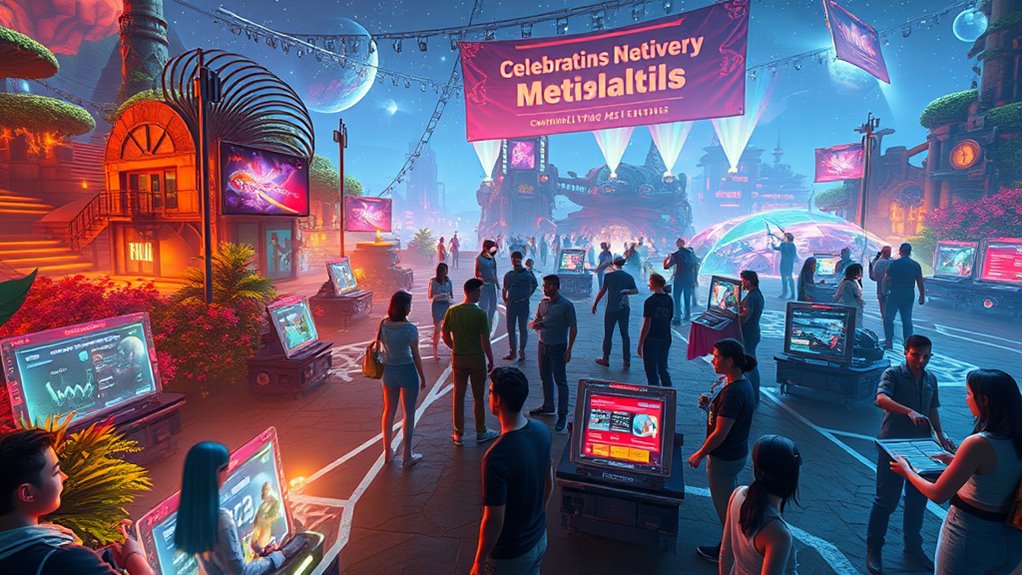
In the domain of metaverse and Web3 gaming, building communities through gameplay involves several key dynamics.
Social interaction dynamics, collaborative gameplay mechanics, and engagement through virtual events foster connections among players, creating a sense of belonging.
These elements not only enhance the gaming experience but also encourage players to actively participate and contribute to their communities.
Social Interaction Dynamics
As players engage within metaverse gaming platforms, the dynamics of social interaction become essential for building strong communities.
These platforms create spaces where players can connect beyond traditional gaming. Key aspects include:
- Unified Platforms: Games like Roblox and Fortnite serve as social hubs, hosting varied activities such as concerts and shows.
- Dynamic Interactions: Shared experiences foster a sense of belonging among players, enhancing community ties.
- Virtual Events: Live events attract large audiences, providing opportunities for entertainment and socializing.
- User-Created Content: Players can design and share their environments, encouraging creativity and deeper engagement.
These elements illustrate how social interaction within the metaverse cultivates vibrant communities, enriching the gaming experience for all participants.
Collaborative Gameplay Mechanics
Collaborative gameplay mechanics play a significant role in fostering community building within metaverse and Web3 gaming platforms. These mechanics often include team-based challenges that encourage players to work together, creating strong bonds and shared achievements.
Additionally, interoperable assets allow players to collaborate across different games, enhancing their connections. Cooperative storytelling enables players to progress through narratives as a team, further strengthening social ties.
Community governance through blockchain allows players to participate in decision-making, fostering ownership and involvement. Furthermore, decentralized project management invites player contributions to game development, ensuring alignment with community needs.
Together, these elements enhance player engagement and promote a vibrant, interconnected community within the gaming ecosystem.
Virtual Events Engagement
Virtual events in the metaverse represent a significant shift in how communities engage and build connections through gameplay. These events leverage advanced technologies to create immersive experiences, allowing for global participation.
Key aspects include:
- Cost Efficiency: Virtual events are 75% cheaper than traditional ones, making them accessible to a wider audience.
- Increased Engagement: Features like live polls and gamification enhance interaction, resulting in higher attendee satisfaction rates.
- Community Building: Platforms such as Fortnite and Roblox facilitate social interactions, encouraging community formation through shared activities.
- Data Utilization: Greater data collection opportunities allow organizers to optimize future events based on attendee behavior.
Financial Opportunities in Virtual Worlds
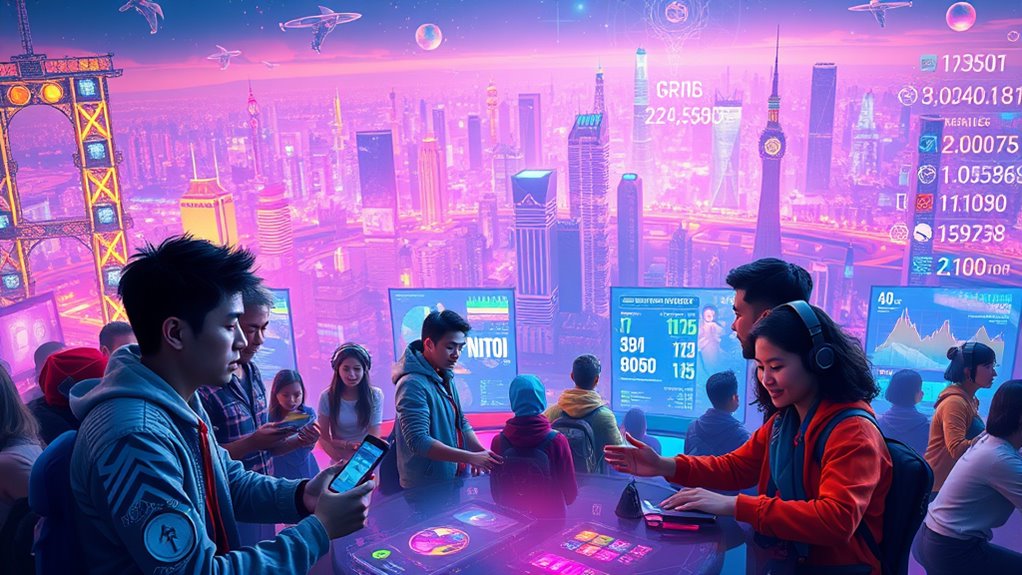
The emergence of financial opportunities in virtual worlds has transformed the landscape of gaming, allowing players to engage in activities that generate real-world income.
Play-to-earn models enable participants to earn money through in-game tasks, while token rewards can be exchanged for cryptocurrencies or fiat currency.
Players also have the option to trade in-game assets, such as NFTs, creating additional revenue streams.
Monetization strategies like free-to-play models and subscription services further enhance profit potential for both players and developers.
The integration of blockchain technology guarantees secure financial transactions within these virtual economies.
As players invest and participate in these ecosystems, they contribute to the growing economic impact of gaming, which now rivals traditional employment opportunities in some cases.
Ownership Models With Digital Assets

Ownership models with digital assets represent a notable shift in how players interact with and invest in gaming environments. These models are primarily driven by the tokenization of in-game assets, which enables true ownership and enhances player engagement.
Ownership models with digital assets are transforming player interactions, enabling true ownership and fostering deeper engagement in gaming.
Key aspects include:
- True Ownership: Players have verifiable ownership of items, reducing risks of fraud.
- Player-Driven Economy: Players can trade, sell, or transfer assets, fostering economic activity within games.
- Cross-Game Interoperability: Assets can be utilized across multiple platforms, increasing their value and utility.
- Enhanced Engagement: Players feel more invested, leading to higher retention and satisfaction levels.
As ownership models evolve, they notably impact player experiences, promoting deeper emotional connections to games and their ecosystems. This transformation is supported by the integration of cryptocurrencies for secure transactions, allowing for seamless exchanges within the metaverse gaming landscape.
The Rise of Play-to-Earn Ecosystems

As players seek more than just entertainment from their gaming experiences, the rise of play-to-earn ecosystems has transformed the landscape of digital gaming.
These ecosystems reward players with assets of real-world value, such as cryptocurrencies and NFTs, for their in-game achievements. Unlike traditional games, play-to-earn models allow players to generate income through gameplay, enhancing engagement and motivation.
Key components include blockchain platforms that tokenize assets, NFTs, and decentralized finance activities that provide passive income opportunities.
This model not only recognizes players’ skills and investments but also fosters community building and sustainable gaming environments.
Integration of Blockchain Technology
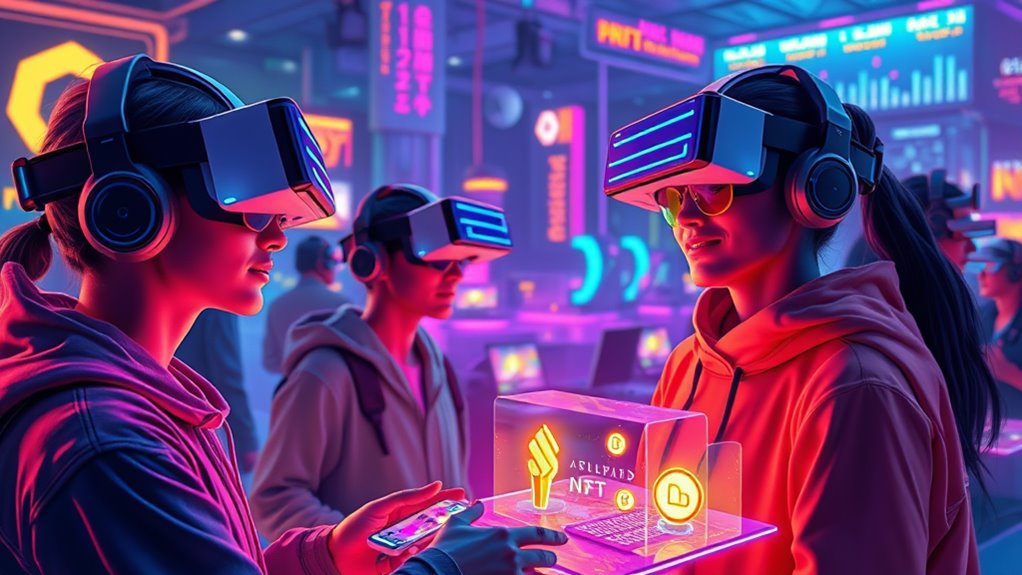
Integrating blockchain technology into gaming platforms has reshaped how players interact with digital environments and manage in-game assets. This innovative approach introduces several key features that enhance player experiences:
- Decentralized Infrastructure: Reduces reliance on intermediaries, enhancing transparency and security.
- Smart Contracts: Automate game rules, guaranteeing fairness and consistency.
- Player Ownership: Enables true ownership of in-game assets, allowing for trading and monetization.
- Immutable Data: Guarantees that all transactions and ownership records are secure and transparent.
These features contribute to a more engaging and trustworthy gaming environment, where players can confidently participate in economies, trade unique assets, and enjoy a sense of real ownership over their digital experiences. Additionally, the use of smart contracts allows for more complex interactions within games, similar to how Ethereum supports decentralized applications (dApps).
Cross-Platform Portability of Assets

Cross-platform portability of assets in gaming allows players to utilize their digital items across various games, enhancing their overall experience.
This interoperability increases player flexibility, as assets can serve multiple purposes and contribute to a player’s digital identity.
As developers embrace these innovations, the potential for collaboration and a more interconnected gaming ecosystem grows, addressing both technical and legal challenges along the way.
Digital Asset Interoperability
Digital asset interoperability allows players to use their digital items across various games, enhancing the overall experience of ownership and utility. This concept facilitates the creation of a seamless metaverse by enabling true asset portability.
Key advantages include:
- Ownership Reinforcement: Players gain true ownership of assets, easily transferable between games.
- Value Enhancement: Assets increase in value due to their usability across multiple platforms.
- Collaborative Opportunities: Developers are encouraged to collaborate, fostering shared experiences.
- Economic Integration: Interoperability supports the seamless integration of diverse virtual economies.
Despite these benefits, challenges such as technical complexities and potential conflicts in monetization strategies persist.
Nevertheless, advancements in blockchain technology and game engine support are paving the way for improved interoperability in gaming environments.
Enhanced Player Flexibility
Enhanced player flexibility through cross-platform portability of assets represents a significant advancement in the gaming industry. This feature allows players to access their favorite games across multiple platforms, enhancing their overall experience.
Developers benefit from a unified codebase, which simplifies updates and reduces costs. Cross-platform gaming fosters a unified community, enabling players to interact and compete regardless of their device. This inclusivity broadens the audience reach, increasing accessibility and potential revenue for developers.
Players enjoy a seamless experience, purchasing a game once and accessing it on various devices. Additionally, engines like Unity and Unreal facilitate efficient cross-platform development, allowing for faster production and easier maintenance, ultimately leading to higher player satisfaction and engagement.
Market Trends Shaping Player Engagement
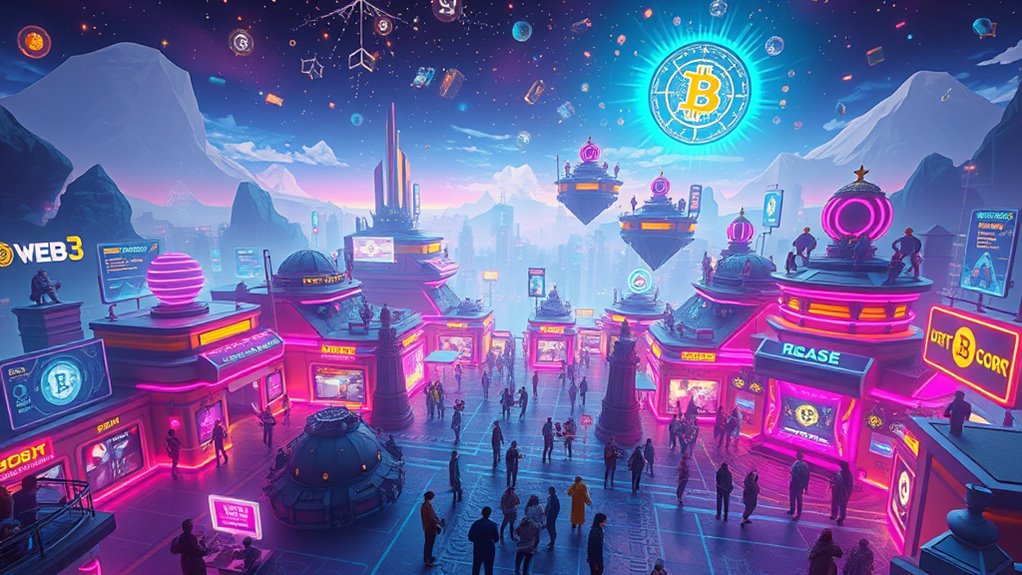
The evolving landscape of Web3 gaming is greatly influenced by market trends that are reshaping player engagement.
Market trends are transforming the Web3 gaming landscape, significantly enhancing player engagement and interaction.
Key factors driving this transformation include:
- Projected Market Size: Expected to grow from USD 24.11 billion in 2024 to USD 131.6 billion by 2034.
- Blockchain Integration: Enhances security and player ownership of digital assets, fostering trust and engagement.
- Play-to-Earn Models: Games incentivize participation, allowing players to earn financial rewards through NFT-based assets.
- Community Governance: Decentralized Autonomous Organizations (DAOs) empower players to influence game development, creating a collaborative environment.
These trends illustrate how technological advancements and evolving player expectations are shaping the Web3 gaming market, leading to increased engagement and participation.
Frequently Asked Questions
What Are the Risks of Investing in Virtual Assets?
Investing in virtual assets entails significant risks, including market volatility, security vulnerabilities, regulatory uncertainty, and lack of intrinsic value, which can lead to financial losses and complications for investors traversing this complex landscape.
How Does Player Feedback Influence Game Development?
Research indicates that games incorporating player feedback can see up to a 30% increase in retention rates. This feedback guides developers in refining mechanics, enhancing engagement, and fostering community trust, ultimately driving long-term success.
Are There Any Age Restrictions for Participating in Web3 Gaming?
Age restrictions for participating in Web3 gaming vary considerably by jurisdiction. While no universal regulations exist, existing online gaming laws apply, and smart contracts can facilitate age verification to enhance compliance and user safety.
What Skills Can Players Develop Through Metaverse Gaming?
In a world where mastering digital domains trumps traditional skills, players can develop creativity, social acumen, financial literacy, and technical expertise through immersive gaming experiences, transforming them into savvy digital citizens maneuvering an increasingly complex virtual landscape.
How Do Regulatory Changes Affect Player Rights in the Metaverse?
Regulatory changes greatly impact player rights in the metaverse, enhancing data privacy and safety measures while mandating transparent payment mechanisms. These developments aim to protect users from harmful content and guarantee fair practices within digital environments.
Conclusion
To sum up, the evolution of metaverse and Web3 gaming platforms reflects significant trends that enhance player engagement. Like a well-crafted tapestry, each element—immersive experiences, community building, and financial opportunities—intertwines to create a rich environment for gamers. As blockchain technology and digital asset ownership continue to grow, the landscape of gaming is transforming. Understanding these trends is essential for players and developers alike, as they shape the future of virtual interactions and gameplay dynamics.


